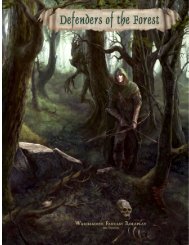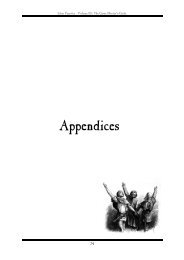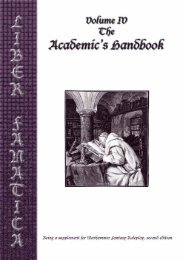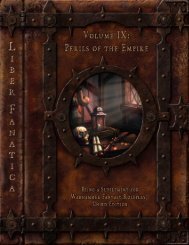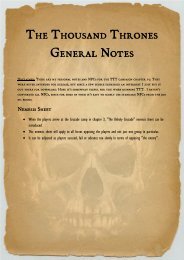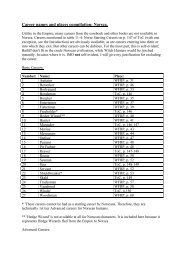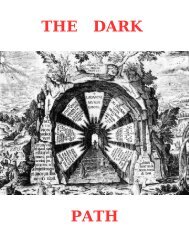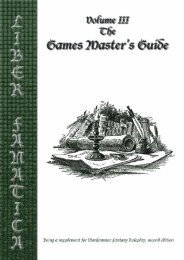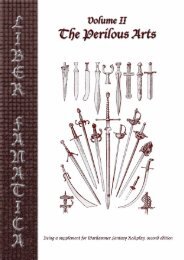Defenders of the Forest - Liber Fanatica
Defenders of the Forest - Liber Fanatica
Defenders of the Forest - Liber Fanatica
You also want an ePaper? Increase the reach of your titles
YUMPU automatically turns print PDFs into web optimized ePapers that Google loves.
Ma n-Fl e s h<br />
Centigors have a greater than normal appetite for man-flesh.<br />
Beastmen ravage <strong>the</strong> areas through which <strong>the</strong>ir warherds pass,<br />
slaughtering and devouring villagers in bloody feasts. Their<br />
unnatural ability to detect <strong>the</strong> scent <strong>of</strong> Humans <strong>of</strong>ten causes<br />
drunken Centigors to forget <strong>the</strong> commands <strong>of</strong> <strong>the</strong>ir Beastlord.<br />
A favoured torture method amongst <strong>the</strong> kings and potentates<br />
in <strong>the</strong> early days <strong>of</strong> <strong>the</strong> sou<strong>the</strong>rn Old World involved locking<br />
captives within <strong>the</strong> belly <strong>of</strong> a brass oven shaped in <strong>the</strong> form <strong>of</strong><br />
a Centigor. A fire was lit beneath <strong>the</strong> device, and <strong>the</strong> screams <strong>of</strong><br />
victims were channelled through tubes and valves as <strong>the</strong>y were<br />
roasted alive, causing a dreadful bellowing sound to emit from<br />
<strong>the</strong> brass beast’s mouth. Chaos Dwarfs use a similar device for<br />
dedicating sacrifices to <strong>the</strong>ir god, Hashut.<br />
Chapter XI: Flora, Fauna<br />
and Foes <strong>of</strong> <strong>the</strong> <strong>Forest</strong><br />
Special Rules:<br />
• Woodland Stride: Centigors are able to gallop along winding<br />
tracks and weave through <strong>the</strong> trees with great speed, ignoring all<br />
movement penalties in woodlands (see WFRP pg. 137).<br />
• Blood-scent: Centigors can smell Humans from a great<br />
distance, gaining a +20% bonus to all Follow Trail and Perception<br />
Tests involving humans. This ability makes <strong>the</strong>m excellent<br />
scouts for a warherd.<br />
Mi n o t a u r s<br />
Source: Tome <strong>of</strong> Corruption, pg. 104<br />
Ma r k o f t h e Be a s t<br />
The earliest accounts <strong>of</strong> Minotaurs can be found in Estalian<br />
mythology and heroic tales such as <strong>the</strong> poem “Prince <strong>of</strong> Tylos<br />
and <strong>the</strong> Minotaur”. In this ancient fable, <strong>the</strong> valiant prince volunteered<br />
himself as bait to lure <strong>the</strong> beast away from his people<br />
and into <strong>the</strong> labyrinth <strong>of</strong> <strong>the</strong> Abasko Mountains. The tale reveals<br />
that an ancient king’s wife had been cursed, and that it was she<br />
who bir<strong>the</strong>d <strong>the</strong> strange beast into <strong>the</strong> world. Minotaurs believe<br />
this beast-child <strong>of</strong> <strong>the</strong>ir ancestry was <strong>the</strong> legendary Mugrar, <strong>the</strong><br />
Lord <strong>of</strong> Minotaurs. Estalians play out <strong>the</strong> struggle between man<br />
and beast with <strong>the</strong> Toreo, <strong>the</strong> sport <strong>of</strong> bull-dancing. Most scholars<br />
assume Minotaurs are a larger sub-species <strong>of</strong> Gors.<br />
Minotaurs are guardians <strong>of</strong> sinister shrines located in <strong>the</strong> darker<br />
parts <strong>of</strong> <strong>the</strong> forest where only a Bray-Shaman would dare to<br />
tread. Although <strong>the</strong>y are normally solitary creatures, <strong>the</strong> smell<br />
<strong>of</strong> blood and <strong>the</strong> sound <strong>of</strong> battle draw Minotaurs to a warherd.<br />
O<strong>the</strong>r Beastmen believe Minotaurs are favoured by <strong>the</strong> Chaos<br />
Gods, or perhaps living manifestations <strong>of</strong> Wild Chaos made<br />
flesh. When a Minotaur falls in battle, <strong>the</strong> warherd receives its<br />
death as a bad omen which invariably results in challenges to <strong>the</strong><br />
Beastlord’s leadership.<br />
La i r s a n d Tr e a s u r e<br />
Minotaurs travel for miles, instinctively drawn to <strong>the</strong> magical<br />
fulcrums that leak Wild Chaos into <strong>the</strong> world (see pg. 115).<br />
While in transit <strong>the</strong>y favour caves as temporary shelters, and<br />
<strong>the</strong>y only remain stationary until <strong>the</strong> urge to continue <strong>the</strong>ir<br />
search for Wild Chaos becomes powerful enough to spur <strong>the</strong>m<br />
onward.<br />
Minotaur caves or shrine glades are littered with excrement and<br />
bones that have been split apart for marrow. The skulls <strong>of</strong> fallen<br />
victims, along with <strong>the</strong>ir weapons and armour, are <strong>of</strong>ten piled<br />
into grotesque monuments to <strong>the</strong> dark gods. Such shrines are<br />
typically located within <strong>the</strong> heart <strong>of</strong> a labyrinthine cave system<br />
or thicket. Guardians <strong>of</strong> <strong>the</strong>se shrines, <strong>of</strong>ten called Doombulls,<br />
are challenged by o<strong>the</strong>r Minotaurs seeking <strong>the</strong> dark gods’ favour.<br />
Bray-Shamans also visit Minotaur shrines seeking communion<br />
with Dark Powers or access to sources <strong>of</strong> Wild Chaos.<br />
Tu s k g o r s<br />
Source: Tome <strong>of</strong> Corruption, pg. 105<br />
Be a s t s o f Bu r d e n<br />
It is well known that after Beastman warherds have passed<br />
through an area, <strong>the</strong>y <strong>of</strong>ten leave surprises for returning villagers<br />
in <strong>the</strong> form <strong>of</strong> mutated lambs and calves. These corrupted<br />
livestock are commonly slain and burnt, unless <strong>the</strong> entire stock<br />
is threatened and cannot be replaced.<br />
One sub-species <strong>of</strong> Beastmen, called Tuskgors, are products <strong>of</strong><br />
similar crossbreeding. Wild boars are warped by <strong>the</strong> corrupting<br />
119<br />
power <strong>of</strong> Chaos, channelled through dark rituals and sacrifices<br />
performed by Bray-Shamans under <strong>the</strong> shadows <strong>of</strong> Herdstones.<br />
Imperial scholars believe that Bray-Shamans choose <strong>the</strong> Wild<br />
Boar for <strong>the</strong>ir rituals because, to early Human tribes, <strong>the</strong> animal<br />
represented strength and courage.<br />
The story <strong>of</strong> Sigmar and Blacktusk <strong>the</strong> Boar is <strong>the</strong> most iconic<br />
example <strong>of</strong> boar reverence. After <strong>the</strong> raging Blacktusk was driven<br />
mad by a spear-tip lodged in its flank, <strong>the</strong> animal was relieved<br />
<strong>of</strong> its pain by Sigmar and released back into <strong>the</strong> forest. The Asrai<br />
simply regard Tuskgors as abominations that are used as beasts<br />
<strong>of</strong> burden to pull <strong>the</strong> Gors’ crude chariots.



